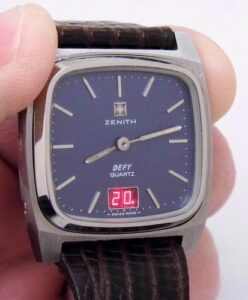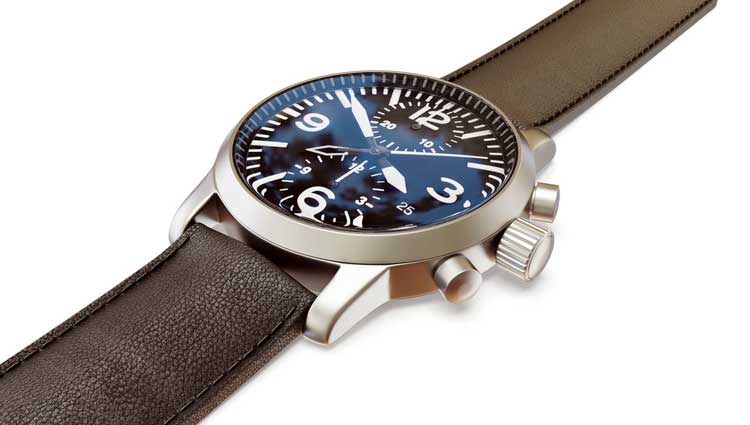Beginning in the latter half of the 20th century, wristwatches began to get cheaper and more accurate. This was due to the invention of the quartz watch, which is an electrical or battery-powered watch. Quartz is the most common alternative to a mechanical watch.
Quartz watches can be cheap or jaw-droppingly expensive. What quartz watches all do have in common is great timekeeping accuracy. To understand why quartz watches are so accurate compared to mechanical watches we need to look at the movement. A quartz watch movement always oscillates at the same frequency and doesn’t have the friction that causes mechanical watches to lose accuracy over time.

Quartz Watch Origins
You may never have heard of the “quartz crisis,” but if you were a watchmaker or watch aficionado in the 1970s, it was unavoidable. The watchmaking industry had seen many advancements in the centuries since the first pocket watch was invented in the early 16th century, but nothing had been as seismic as the creation of the quartz watch.
The first quartz clock was created in 1927 at Bell Telephone Laboratories. In the 20th century, the mythical Bell Labs was the birthplace of many of the world’s most transformative inventions, and the quartz clock certainly transformed the world. It was years before the quartz mechanics were made small enough to fit into a watch, but when it happened, everything changed. So began the quartz revolution (one person’s revolution is another’s crisis).
That pivotal moment happened on Christmas Day, 1969. Seiko, a Japanese watchmaking company, released the Astron, a limited edition watch that cost as much as a car. Despite those pricey beginnings, it would take only a few more years before quartz watches were so abundant that the formerly dominant watchmakers of Switzerland were in a panic.
Analog vs Digital Watches
For most of their history, watches have been analog. That is to say, they have had a face with a physical hour, minutes, and, usually, second hand. The quartz revolution in watchmaking coincided with the explosion of digital watches, which have electronic light displays. The first digital watch was released to the public in 1972 and was created by an American company, Hamilton Watch Co.
Though the first digital watch was American, it was Japan that took the concept, improved it, and made it cheaper. Seiko, naturally, led the charge and was soon one of the biggest watchmakers in the world. The groundbreaking company smartly opted to make both quartz analog and digital watches, helping them to continue to dominate a market they helped invent.
Timekeeping Basics
To appreciate the huge transformation that quartz watches ushered in is to understand how a quartz watch works, and that first requires briefly discussing how watches in general operate.
The original clocks used a mix of swinging pendulums and gears to keep track of seconds and then calculate up to count out minutes and hours. The revelation that pendulums were an ideal tool for keeping accurate time was first made by Galileo Galilei, perhaps best known for being the man whose defense of heliocentrism led to his house arrest for the rest of his life.
Pendulums are, indeed, handy, but hardly practical to wear on your wrists. Mechanical watches replaced them with escapements and oscillators. These two parts work together like a pendulum, tracking the passing of time through back-and-forth movements. For centuries, that was the most accurate means of keeping time. Then quartz oscillations were discovered.
🏆 #1 Best Overall
- Help your watch change the "core" dirty, lasting performance and mute.
- 2035 Shi Ying movement, not easy to damage.
- Package included:Ximimark 2Pcs 2035 Quartz Watch Movement Battery Included for Japan Miyota 2035 Replacement Repairlor
- Thank you very much for shopping in our store. Please feel free to contact us if you have any questions.
How Do Quartz Watches Work?
Quartz is the second most common mineral on earth, but aside from its abundance, its most important feature is that it is piezoelectric. When electricity is sent through a quartz crystal, it vibrates or oscillates. The frequency at which quartz crystals oscillate, always 32,678 times per second, is used to determine the passage of time.
A quartz watch uses battery power to send a constant electric charge through the quartz crystal. A quartz watch, like a mechanical watch, has gears that turn the hands (assuming it’s a mechanical watch; digital displays are entirely different), but whereas a mechanical watch depends on the oscillator to keep time, in a quartz watch, the quartz crystal is the timekeeper.
Why Quartz Watches Are More Accurate Than Mechanical?
You now know the basics of how a quartz watch works, but why would a quartz watch be inherently more accurate than a mechanical watch? Well, there are a variety of factors, but the first one we’ll focus on is basic physics.
For a mechanical watch to oscillate, energy must be sent through its many parts to turn the gears, escapement, and oscillator. That energy is either supplied by manually winding the watch or, in automatic watches, by the natural movement of the wearer’s wrists.
Those moving parts create friction and consume energy, meaning that no matter how regularly you wind your watch, some of your effort is being lost. A quartz watch minimizes moving parts and gets its energy from a battery, so the power necessary to keep the crystal oscillating isn’t lost.
Speaking of oscillations, the natural frequency of quartz is also just a much more reliable means of keeping time than the physical movements of a mechanical watch, no matter how well-crafted it might be. Even the greatest watchmakers in Switzerland are constrained by the physical realities of creating an incredibly intricate machine.
The slightest mistake will change how accurate the watch works. A quartz crystal will always oscillate at the same frequency, no matter how poorly designed the rest of the watch is.
Finally, timekeeping accuracy is affected by the natural forces of the universe; specifically, gravity. Like everything else, the mechanical parts of a watch are subject to gravity’s pull. Watchmakers have been wrestling with this for centuries, and have found numerous solutions to this problem, including the incredibly cool-looking tourbillon designs.
Modern mechanical watch designs have mostly eliminated the effects of gravity, but for quartz watches, it isn’t even an issue. A quartz crystal will oscillate the same no matter what.
Here is one guy’s take on why a quartz watch should probably be your choice for your everyday carry watch (EDC) – the reliable watch you wear on a daily basis.
Rank #2
- 【Precision Quartz Movement】Crafted with precision, this SL68 quartz watch movement ensures reliable and accurate timekeeping for your timepiece. Built with high-quality components, it delivers a stable and secure performance that lasts, making it an essential replacement part for both professionals and DIY watch enthusiasts.
- 【Durable Replacement Design】Designed for longevity, this watch movement replacement features stable characteristics and high reliability. Its durable build ensures minimal wear and tear over time, significantly reducing the need for frequent replacements. Whether you're repairing vintage watches or modern timepieces, this movement offers consistent and dependable function.
- 【Quick & Tool-Free Setup】Say goodbye to complicated repairs — this easy to install watch movement allows for quick and seamless installation. Simply remove the old movement and replace it with this upgraded SL68 model. No special tools are required, making it perfect for both professional watchmakers and at-home DIY repairs.
- 【Compact & Lightweight Build】This lightweight quartz movement is compact and easy to store, making it ideal for travel or on-the-go repairs. Whether you're a professional repairer or hobbyist, its small size and light weight allow you to keep multiple units in your toolkit without taking up space. Always be ready for your next watch upgrade or fix.
- 【Essential Repairer’s Toolkit】Perfectly suited for a wide range of applications, these watch repair accessories are a must-have for any watchmaker or DIY enthusiast. Whether you're restoring vintage watches or maintaining everyday timepieces, this SL68 quartz movement serves as a reliable and versatile component in your repair kit.
How Much More Accurate Are Quartz Watches?

Like mechanical watches, quartz watches can vary dramatically in quality. Yet, regardless of quality differences, the average accuracy of a standard quartz watch will be greater than or equal to the best mechanical watches in the world.
With all this talk of accuracy, though, it’s important to understand that we’re talking about the gain or loss of mere seconds per day. A typical quartz watch gains or loses one second a day, while the best mechanical watches average three seconds. The best quartz watches on the market average a change of .02 seconds a day.
These changes are so small that you generally only notice them after a collective gain or loss of a few weeks or more. Generally, the only time people need something with greater accuracy than a standard quartz watch is when they’re doing scientific measurements. For those people, there are atomic clocks and watches.
For the rest of us mere mortals, a quartz watch will more than accurate enough to make sure you never miss the start of the big game.
If you’re interested in learning more about quartz watches – read here why some quartz watches have jewels or read about the main differences between quartz and automatic watches.
Rank #3
- [Great Replacement] An excellent alternative to the original movement, providing seamless functionality and accurate timekeeping. upgrade your watch with this premium replacement.
- [Designed with Date Display] This watch movement is elegant and functional, adding a touch of sophistication to your watch. the choice for those who value and utility.
- [Practical Accessory] A must-have tool for watch enthusiasts and professionals. ideal for repairs and customizations, this watch movement is versatile and
- [Easy Installation] Quick and hassle- installation process, making it convenient for watchmakers and repairing workers. save time and effort with this effortless setup.
- [Superior Materials] Made of and materials, ensuring long-lasting performance and reliability. safety and durability are guaranteed with this watch movement.





